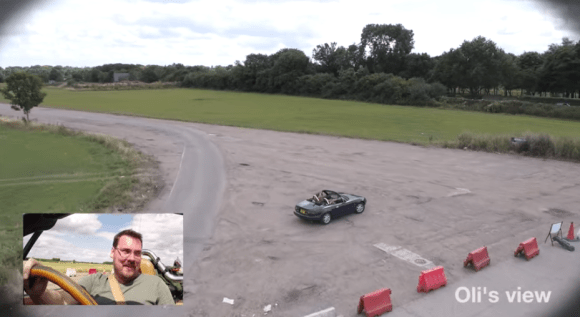
Do you fancy yourself an excellent driver in video games featuring a third person view for the driving experience? Ever wonder what it’d be like in real life? [Tom] and [Oli] wanted to find out so they decided to setup this awesome experiment.
They’re using the Bovingdon airfield, which was a Royal Air Force station during WWII — today it stands empty and is a beloved testing ground for many custom vehicles in the UK, like [Colin Furze’s] world record-setting baby carriage. The car chosen for the challenge is a Mazda MX-5 Miata, which we don’t think they care too much about considering the potential obstacles they’ll be hitting!
The driver wears a set of video goggles, and a co-pilot comes along for the ride to help prevent any major collisions. A hexrotor drone is flown by another person who attempts to keep it mostly behind the car in the stereotypical third person view. The video signal is then transmitted down to the driver in real time.
It looks like a blast and definitely isn’t as easy as you might think — despite ultra low latency, both of the drivers felt that they experience lag during the experience.
For a slightly safer experiment, you could always build a third person camera backpack!















Vision impaired driving is really hard! /s
Cool experiment using limited experiments. For the record, i hit many objects in GTA 5 while driving. That is with HD and no input lag.
20 fps at 720p is not considered “HD with no input lag”
I was refering to the “actual view” at 1.24. That is not HD quality. Also reading on how many gamers are upset when any of the latest two gameconsoles drop below 60FPS, 20 FPS would cause outrage.
You would be surprised on what console users don’t know.
Invalid parameters… No video. I had video last week…
Probably wouldn’t be so bad with a higher quality video feed with a somewhat more fixed distance camera instead of a loosely following drone. Definitely preferred the rosterteeth method with a setup on a boom, minus the googles. Having something like Oculus VR with the boom would be great!
That’s a Eunos Roadster (same thing as an MX5 / Miata)
Bonus points – it is an imported (to the UK) Eunos Roadster, bought specially for this project
That has got to be confusing as hell. You’re getting first person feedback for most senses and third person for delayed visual. Nice experiment!
The problem I have with this is that video game cameras are fixed behind the car, not wandering all over the place. If there was a pole sticking off the back of the car with a camera on it and the feed was going straight to the goggles, I think this would be much easier.
Definitely – also have the driver somewhere else. It’s relatively easy to remote control a car, that way it’d be a much more “video game” experience.
Yes, like Telek said.
The driver is getting motion cues that a gamer wouldn’t normally get.
roster teeth did this very well lol
https://www.youtube.com/watch?v=nIRUavithF8
looks cool – but the camera was way too low, no wonder so much was run over you can’t actually see what’s in front of you.
That is hilarious! And I love the surprise ending.
I’ll just use this place to shamelessly plug my bachelors thesis on autonomous tracking of people using a multicopter.
http://www.justgeek.de/bachelor-thesis/
Doesn’t sound very original. I’m also a douchebag, so check out my site.
This is kind of the opposite of R/C car driving, which has latency on controls but not typically on visuals… you’re usually watching your R/C vehicle directly. But you have to deal with a 3rd party view from any angle, and yet serious RCers can drive 35-70mph (real, not scale) with great success.
The regular analog controllers for R/C give you a 20ms typical latency. When I was designing the first digital R/C controllers at Nomadio, we has this down to 5ms. The second versi p not the controller, the Nomadio React, was also the best controller for computer driving games at the time, with similar low latency through USB drivers.
When you claim “ultra low latency”, that’s not enough… real numbers are necessary to have any real meaning. For this kind of experiment, you’d have to go to some Intra – Frame only digital encoding to have any chance of having low enough latency to drive a car. Things are much more relaxed, usually, when you’re driving a UAV… you have lots of room, not a 12 ft vehicle lane.. or a 3-4 ft R/C track.
there is no encoding in almost all* FPV setups, they all send analog pal/ntsc video.
*there is one digitial full hd FPV setup that I know of, but it ..lags :) and is only usable on quadcopters due to tehir tolerance for delay.
Would fitting a spring return to center the steering not solve at least some of the weird lack of feedback described? I would say that the self centering wheel is what makes driving driving using a steering wheel possible in computer games.
cinematic camera challenge
https://www.youtube.com/watch?v=ySv4Ec4MNdI
I bet a 13 yr old would do just fine.
Been wanting to do this for a while, also just walking, running, playing soccer (or other sports), rock climbing, I just wonder how life would be in 3rd person.